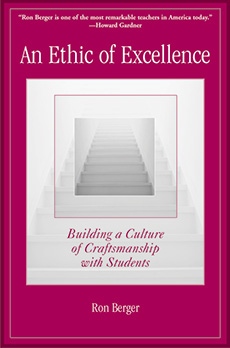It's Time for Educators to Revisit "An Ethic of Excellence." Here's why.
“The particular spark I try to share as a catalyst is a passion for beautiful student work and developing conditions that can make this work possible.” -Ron Berger
It’s time to revisit An Ethic of Excellence.

Ron Berger’s 2003 treatise on building a culture of craftsmanship with students is a look back on his 25-year career as a public school educator and professional development coach. The book is part memoir, part advice column, and part manifesto, but it is primarily a plea to return to the values and practices that shaped formal education: apprenticeship, authenticity, and rigorous exploration. Berger defines “excellence” as student work that has real-world relevance and is assessed against professional standards. This kind of work, he argues, represents centuries-old values of education, values that still matter but that modern schools have lost sight of.
This is why, unlike so many other education books written 20 years ago, An Ethic of Excellence feels more relevant today than ever before. For three years, beginning with the onset of the coronavirus pandemic and continuing most recently with the rapid emergence of artificial intelligence in education, school communities have been wrestling with a near-constant state of instability. We are confronting the same issue that Berger’s book tackled in 2003: What makes learning authentic? How do we ensure that student work reflects deep learning and meaningful impact? Berger argues that the singular representation of authentic learning is — and should be — student work. If we look at the work our students produce on a day-to-day basis, we will see our school’s purpose in action. If we don’t like what we see, the problem is not necessarily with our students, it’s with how we communicate and design for our purpose.
Berger’s voice and perspective are bracingly simple and pragmatic: the book is a powerful 150 pages written by a practitioner, not a theorist, entrepreneur, or “thought leader.” He keeps a tight focus on 1) looking inward, rather than outward, for signs and cues about what matters to your school 2) the classroom as the place where a school’s identity comes to life, and 3) the curation and exaltation of beautiful work as the way to inspire deep work among students and teachers.
Berger identifies three “toolboxes” schools need to nurture an ethic of excellence. For me, they are simple, strong anchors as I navigate the increasingly complex landscape of education.
The First Toolbox: A School Culture of Excellence
“One thing clear to me though is that the power of the culture rests in community.”
A key theme of Berger’s book is that ongoing reflection about and open discussion of core values, as opposed to a focus on adding initiatives or integrating new systems and structures, is what drives a healthy school culture. Creating physical and psychological safety, encouraging openness and transparency, and engaging the community beyond your school form the foundation of a culture of excellence. Nurturing that culture is the job of everyone in the building.
Culture is at the forefront of education right now: nurturing cultures that support belonging, meaning, and connection is essential to the long-term health and sustainability of a school. Berger writes that culture dictates design: we can see our culture in the projects students do, in how teachers and students interact, in how the academic program is structured. In prioritizing a healthy, inclusive school culture, we need to be willing to redesign elements of school to better reflect that goal. Berger suggests we begin with an open conversation that includes all members of the school community: What kind of work do we want our students to do? What needs to be true in order for them to be able to do that work?
The Second Toolbox: Work of Excellence
“We can’t first build the students’ self-esteem and then focus on their work. It is through their own work that their self-esteem will grow.”
Berger’s definition of “work” should be part of the current conversation in education about assessment. He views learning in his classroom as a series of projects, projects measured against the professional standards in whatever fields they touch upon: rigorous scientific research, high-quality artistic work, or community presentations. He rejects standardized tests and other “shallow” modes of assessment in favor of long-term, deep work that belongs in a portfolio and can’t be captured with a simple letter grade or transcript. It’s through this work that students develop the mindset and skillset to pursue excellence, however long it takes. As Berger writes, “a piece of work either deserves an A or a Not Done.”
The learning environment required to support this work is completely different from traditional school structures: space, time, and modes of assessment must elevate practice and reflection over coverage of content. Students and teachers must be committed to the iterative process required to produce excellent work.
As this popular video of Berger reflects, none of this requires investment in new technology or architecture. He is definitively — and, for these times, radically — analog in his approach. The investment he makes here is in helping students understand that feedback is the foundation of beautiful work.
The Third Toolbox: Teaching of Excellence
“Assume that strong teachers do view their profession as a calling and that what they want most is an environment that respects and supports the growth of their teaching practice.”
The role of the teacher must be redefined. Rather than resort to clichés like “guide on the side,” Berger argues for something more complex: teachers are designers of experiences whose goal is to help students become designers of experiences. He writes, “I plan all of my studies and assignments compulsively. I am ready, however, to let go of plans when students convince me of the merit of doing so.”
The proliferation of powerful technology and research on learning has placed enormous pressure on teachers to “change” (whatever that means). What I find so compelling about this section (in fact, it inspired me to write this) is that in Berger’s model, the teacher matters more than ever. It’s what we mean by “teacher” that needs to change. In short, we should stop distinguishing between what we need from teachers and what we need from students and instead expect from and provide to them the same things: excellent work and the time and support to create it.
Berger writes beautifully about his evolution as an educator: he has changed and grown significantly over the years, always driven by a clear purpose to empower his students to produce the best work they can. As an educator, I am inundated with new ideas and encouragement to innovate, and I use this book to ground myself in core values and make intentional decisions about how I want to grow. An Ethic of Excellence is not a rejection of innovation; it is a reminder of what innovation is for.
For more, see:
GOA serves students, teachers, and leaders and is comprised of member schools from around the world, including independent, international, charter, and public schools. Learn more about Becoming a Member. Our professional learning opportunities are open to any educator or school team. Follow us on LinkedIn and Twitter. To stay up to date on GOA learning opportunities, sign up for our newsletter.
